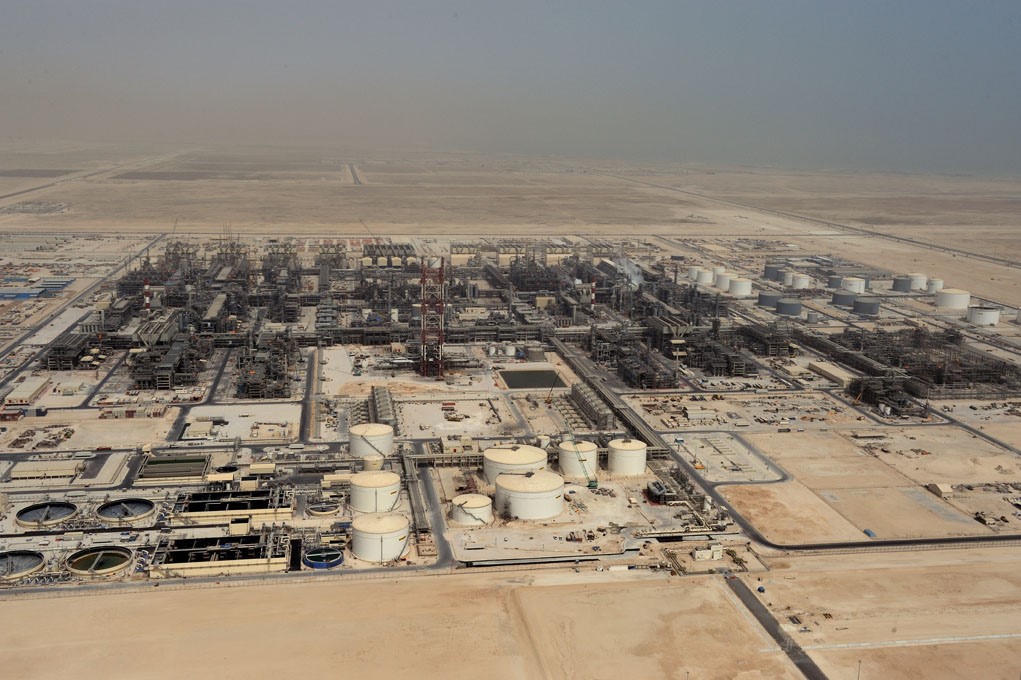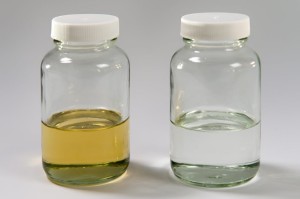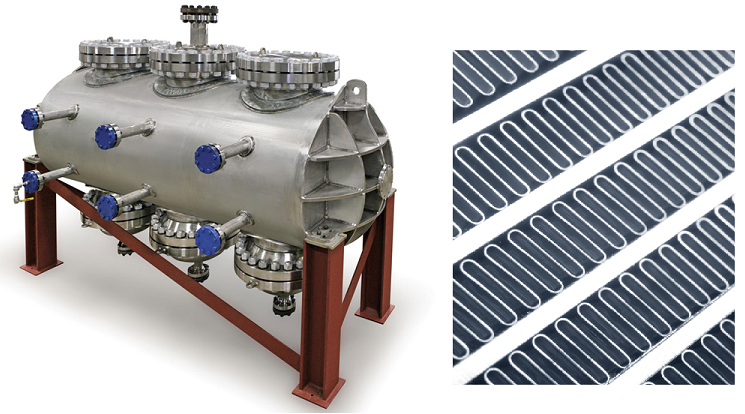Converting natural gas to liquid fuels using Fischer-Tropsch conversion is not a new idea but it has always been a big one, meaning it has always required very large and expensive production facilities. Royal Dutch Shell and South Africa’s Sasol have been the industry leaders in Gas-to-Liquids (GTL) for decades but their existing GTL plants are all mega-projects costing billions of dollars. Velocys is bringing to market new technology for small scale GTL production at a fraction of the capital costs of traditional plants.
Shell’s 140,000 bpd Pearl GTL plant in Qatar. Photo by Shell
Fischer-Tropsch (F-T) synthesis enables the production of synthetic liquid fuels and waxes from natural gas and other hydrocarbons such as coal or biomass. F-T synthetic diesel and jet fuels are extremely high quality, they burn cleaner and quieter than conventional petroleum fuels because they contain no sulfur and enable reduced particulate emissions. Every winner of the 24 Hours at Le Mans auto race since 2006 has used GTL diesel fuels. Emerging supplies of low cost natural gas combined with increasing restrictions on emissions are spurring development of new GTL projects around the world.
Conventionally-produced diesel (left) vs F-T diesel (right) with very low impurities. Photo from Velocys
Velocys has pioneered the development of the microchannel F-T reactor that was originally invented in US national labs in the 1990’s for the space program. Microchannel technology utilizes a new type of reactor and catalyst system that enables the entire plant to be completely scaled down while maintaining the same production economies of the mega projects. Since microchannel reactors are small they can be prefabricated and delivered to site, rather than custom built. This standardization and modularization enables Velocys to pursue a much greater variety of projects in locations that are not feasible using conventional reactors.
Conventional GTL technology utilized by Shell and Sasol is only economic for plants producing 30,000 bpd or more. There are only five of these plants in the world, three operated by Shell and two by Sasol and only about 6% of the world’s known gas fields are large enough to sustain GTL plants of that size. In contrast, smaller scale GTL plants are designed to be economic at 1,500 bpd to 15,000 bpd (barrels per day), requiring only 15,000-150,000 mmbtu of gas per day as feedstock. Distributed GTL could unlock up to 50% of the remaining fields that conventional GTL cannot economically exploit.
Velocys Commercial FT reactor capable of producing 125 barrels per day and microchannels. Photos by Velocys
Velocys business model is based on bringing small scale production closer to natural gas resources and getting away from the traditional chemical engineering model of large economies of scale. The economics for mega projects are becoming increasingly challenged as gas resources are becoming more widely distributed. Cost escalation and delays on mega projects are common with cost overruns often reaching 50% or more. Furthermore mega projects take many years to develop and put a strain on supply chains and talent pools. These problems are particularly acute in remote locations where much of the world’s gas is to be found.
Shell recently announced the cancellation of their 140,000 bpd Gulf Coast GTL project due to cost considerations and market uncertainty over the long term spread between gas and diesel prices. Shell’s plant would not have come online until the mid 2020’s which highlights the challenges in investing billions in a facility whose business model is based on arbitraging the long term spread between gas and petroleum prices that are notoriously hard to predict.
The EIA estimates very challenging economic prospects for large scale GTL projects. According to the EIA GTL plants are more economic when configured to sell waxes and lubricating products because the chemicals market is much smaller than the fuel market. F-T waxes are used to produce candles, paints, coatings, resins, plastic, synthetic rubber, tires and other products. EIA recommends GTL developers maximize wax production.
On the other hand the future for small scale GTL at Velocys looks very bright and they are moving ahead with projects and investments.
Velocys’s first commercial plant is now under construction in Oklahoma City, OK. The plant is a joint venture between Velocys, Waste Management Inc, NRG Energy, and Ventech Engineers and will be using renewable landfill gas as a feedstock. The facility is located at Waste Management’s East Oak Landfill and should be ready for commercial operations in the first half of 2016. The JV will pursue the development of multiple plants utilizing a combination of renewable biogas and natural gas. No word yet if they will be pursuing biofuel credits under the Renewable Fuels Standard but the business model does not require it.
Another plant in the planning stages is in Ashtabula, Ohio near Lake Erie using natural gas from the Marcellus Shale. This plant was acquired by Velocys when they purchased small scale GTL project developer Pinto Energy in June 2014. Initial engineering is complete and permits have been issued. This plant will utilize low cost natural gas from the Marcellus and abundant existing infrastructure. Initial production will be 2,800 bpd with expansion potential up to 10,000 bpd as well as high value solvents, lubricants and waxes.
Velocys recently won an injunction against rival CompactGTL, chaired by former BP Chairman Tony Heyward, in a patent infringement case. The UK High Court ordered CompactGTL to immediately cease activities that infringed on two patents held by Velocys and to pay Velocys £1.4 million for damages and legal costs. Velocys has a very substantial patent portfolio consisting of over 900 patents in many countries.
In September, 2014 Velocys raised approximately $85 million in an equity placing that was oversubscribed and priced premium to the market. The equity raising represents a big vote of confidence from Wall Street.


